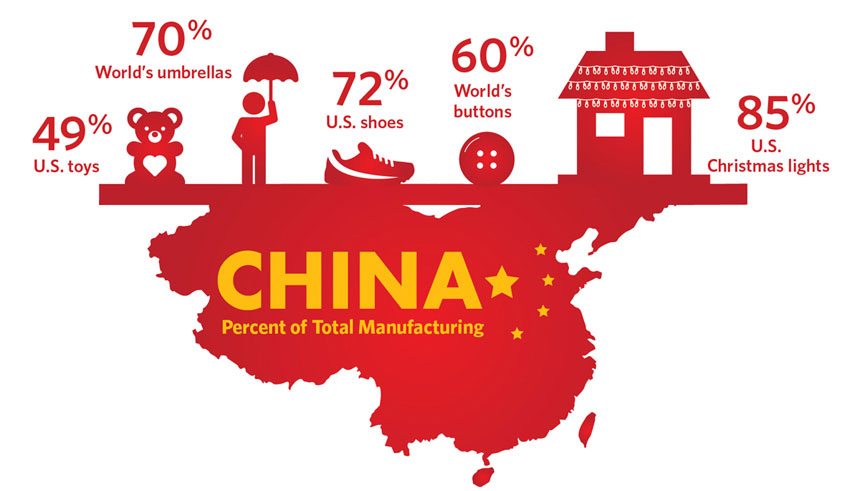U.S.-Asia Business
American Companies Face Changing China Manufacturing Industry
By Ellen Chang

How companies are adapting to China’s stricter manufacturing regulations.
A growing number of companies manufacturing their goods in China, including American businesses, are facing greater challenges as the labor laws have become stricter and other legal issues remain unclear.
Chinese regulators have enforced additional safety regulations for laborers in the factories that have added to the cost for companies. One example is Gensun Casual Living Company, a Rancho Cucamonga, Calif.-based business that manufactures high-end patio furniture and distributes them in North America, Australia and New Zealand to specialty brick-and-mortar and online stores.
“Instead of allowing employees to live in dormitories provided by the manufacturers, companies now have to lease an apartment building or other dormitory-style housing,” says Lisa Zhou, CEO and president of Gensun Casual Living Company.
This change in the labor laws means Gensun must offer transportation to the employees, pay overtime and offer three employment shifts per day. The company has also constructed additional facilities, such as areas where employees can shower before or after shifts.
“We have experienced higher labor costs due to the safety regulations,” she says. “The policies regarding safety in the working environment are also very strict.”
"Traditional manufacturing is not that easy anymore. However, we are not sacrificing our quality to make a cheaper product."

The government instituted additional regulations after the devastating Tianjin explosion, where over 100 workers were killed and hundreds of others injured.
Gensun has 800 employees working in its two factories in the Hebei province and Tianjin. Adjusting to the changes made by regulators has only impacted the company’s profit margin minimally because the cost of the aluminum used to make their products continues to decline, and the U.S. dollar remains strong compared to China’s renminbi.
“Our overall costs did not increase,” says Zhou. “Land costs are pretty high in China, and labor costs are rising, so traditional manufacturing is not that easy anymore. However, we are not sacrificing our quality to make a cheaper product.”
One emerging shift that companies must cope with is that employees in China are expressing higher expectations, and many do not want to leave the countryside and commute into cities, shares Dr. Doug Allen, director of the Daniels College of Business International MBA program and associate professor of management, at the University of Denver’s Daniels College of Business.
“They want to find jobs closer to home and not make the long commute, which means companies are facing the potential of a shortage of workers who are capable of carrying out skilled positions,” he says.
The salaries of employees are also rising, and those of entry-level workers have risen by 10 percent to 15 percent during the past five years, adding pressure for companies to offer other benefits, Allen said.
One in four U.S. companies with operations based in China have considered or plan to move their factories or employees to other countries in Asia, North America or elsewhere, according to a 2016 survey of 500 companies conducted by the American Chamber of Commerce in China.

"American companies must shift their business strategies in order to generate a profit in China. There is a lot of innovation possible in business models, operations and services, and the U.S. is really strong in that."
The companies said the murky laws are frustrating, and varying interpretations of the new regulations, along with the challenges of obtaining required licenses, have resulted in complicating their operations.
The survey revealed that 45 percent of companies reported flat or declining revenues in 2015 compared to 2014. The number of companies who said their businesses were profitable in 2015 also declined to 64 percent, the lowest level reported during the past five years. The poll also showed that China remains a top investment priority for more than half of the companies, and the no. 1 priority for about 25 percent of members.
“American companies must shift their business strategies in order to generate a profit in China,” says AmCham China Chairman James Zimmerman. For companies committed to growth in China, innovation is a critical priority in all segments of their business, no matter if they are a small or large firm.
“There is a lot of innovation possible in business models, operations and services, and the U.S. is really strong in that,” he says. “They have to innovate in terms of what is the actual value that they are trying to deliver, financing and in terms of implementing something that gives an actual result as opposed to just selling a piece of hardware.”
Made in China 2025 is the country’s plan to remedy its manufacturing issues by implementing big data and the Internet of Things to compete with its competitors in the United States, Germany and Japan. The goals include creating greater efficiency, adding 15 innovation centers by 2020 and 40 centers by 2025 and localizing its materials. China aims to remain competitive by boosting productivity and producing higher-value goods, with leaders launching China’s most comprehensive and ambitious industrial plan to upgrade manufacturing by changing their hiring process to include more men and shift from the traditional model of women, improve wages and increase benefits.
According to the 2016 AmCham China Business Climate Survey, nearly two in three service companies reported increased revenues, while almost half of industrial and resource companies reported decreased revenue.
“Our member companies prioritize innovation in China, with 44 percent of them considering innovation as at least a top three priority for their growth in China,” says Zimmerman.
How companies adapt
In the meantime, American employers have to work harder at attracting their “dwindling supply” of workers, especially skilled and middle-level ones, adds Allen.
“Employees want more than pay, and it is no longer a sufficient formula,” he says. “They want opportunities for development and advancement, better managers, fair treatment and work/life balance.”
Many employees now are seeking to advance from their current positions but want to remain at the same company. Many businesses are responding to the needs of their workers and are providing more meaningful job skills, such as teaching them customer service. Employees are interested in jobs outside of the factory such as service-oriented ones, Allen says.
Some companies are also helping their employees obtain permits to live in other cities outside of their region, which provides a “stepping stone to other opportunities,” he adds. “Companies can distinguish themselves as an employer of choice and also hire ones with better qualifications to engage with customers directly.”
Companies can continue their profitability by maintaining their strict and reliable manufacturing standards. By keeping their higher standards, customers will not seek other manufacturers. One strategy is to avoid the stereotype that products made in China are cheap, according to Zhou.
“Break that mold because if you make a cheaper product or one with quality issues, your company could lose its reputation,” she says.
While companies can make a profit on a short-term basis when they sell a cheaper product, customers will avoid your company and seek better items elsewhere.
“You want to be consistent since the market is oversaturated, so find your niche in the market,” Zhou shares. “In every single field, there are tons of competitors.”
The no. 1 priority for companies to follow is maintaining their quality and the second one is delivering products on time. Even if there are delivery issues and a shipment from China is delayed by a week or two, telling the customers the truth is vital.
“People can accept it if you don’t create a story and lie about it,” she says.
Establishing a company’s brand by making high quality products is paramount.
“There is always a new company out there, so you have to stay on top of it,” says Zhou, who has been running her company for 15 years. “Keep your word and having a quality reputation in the U.S. is so important. This benefit will last for many years.”

